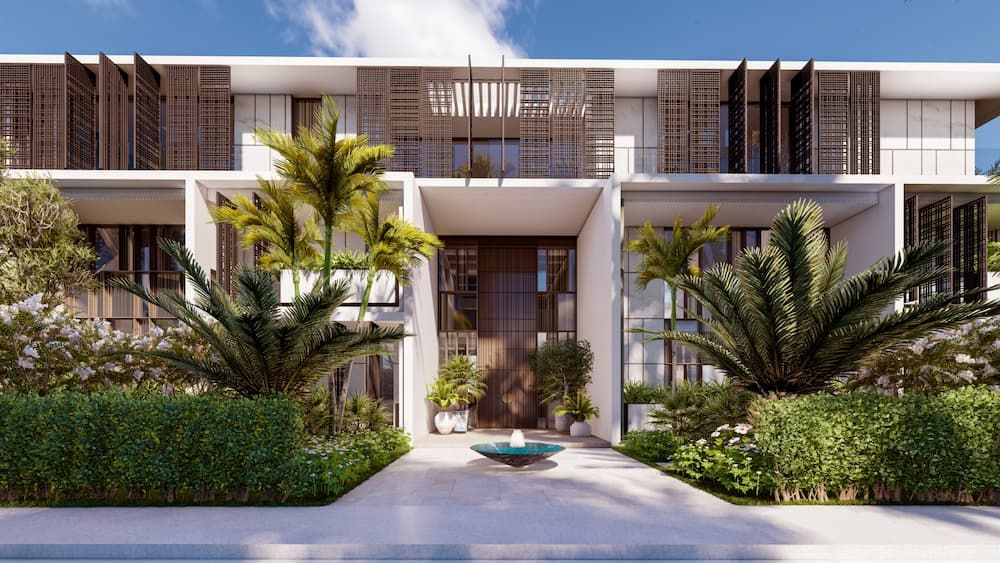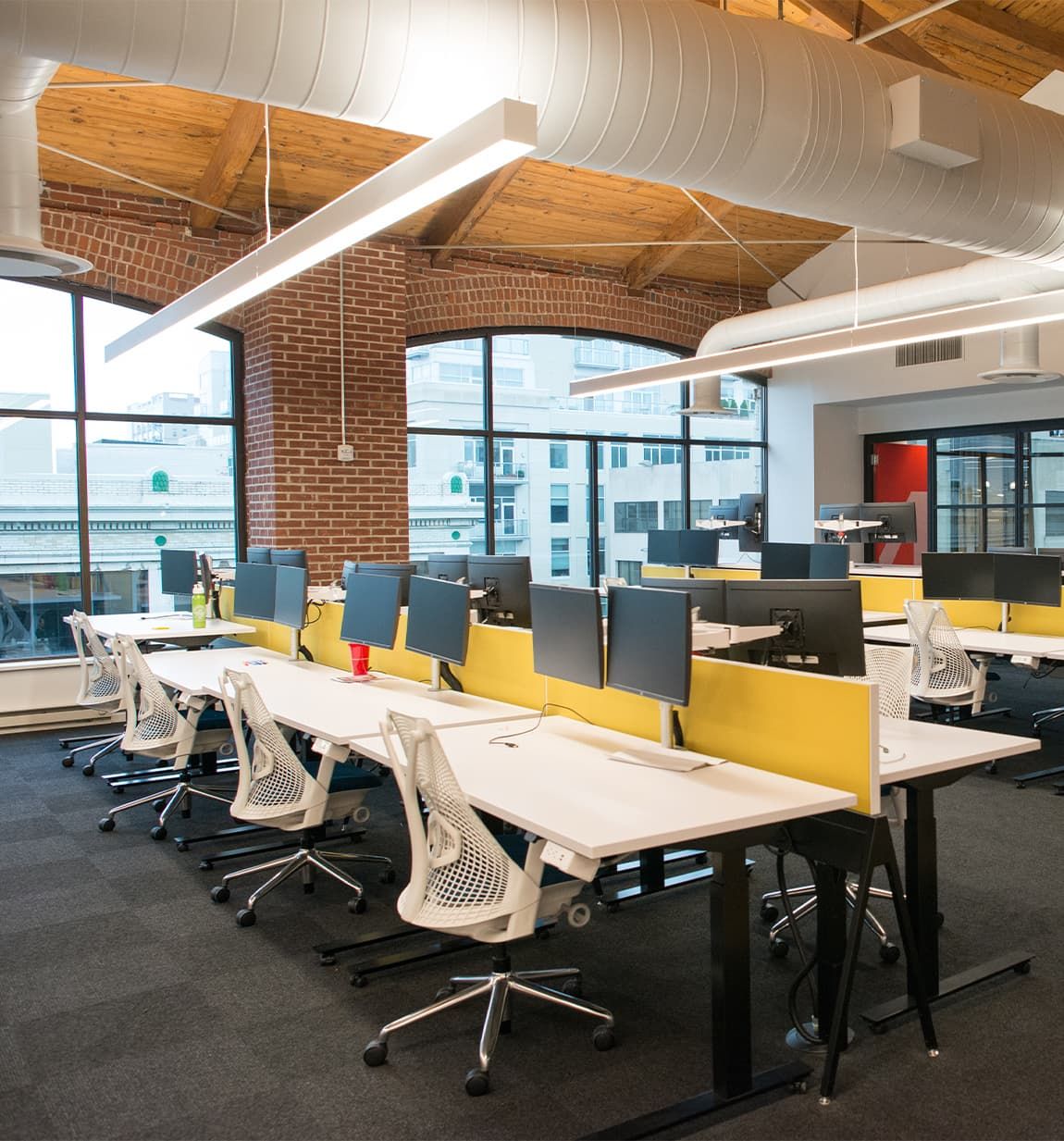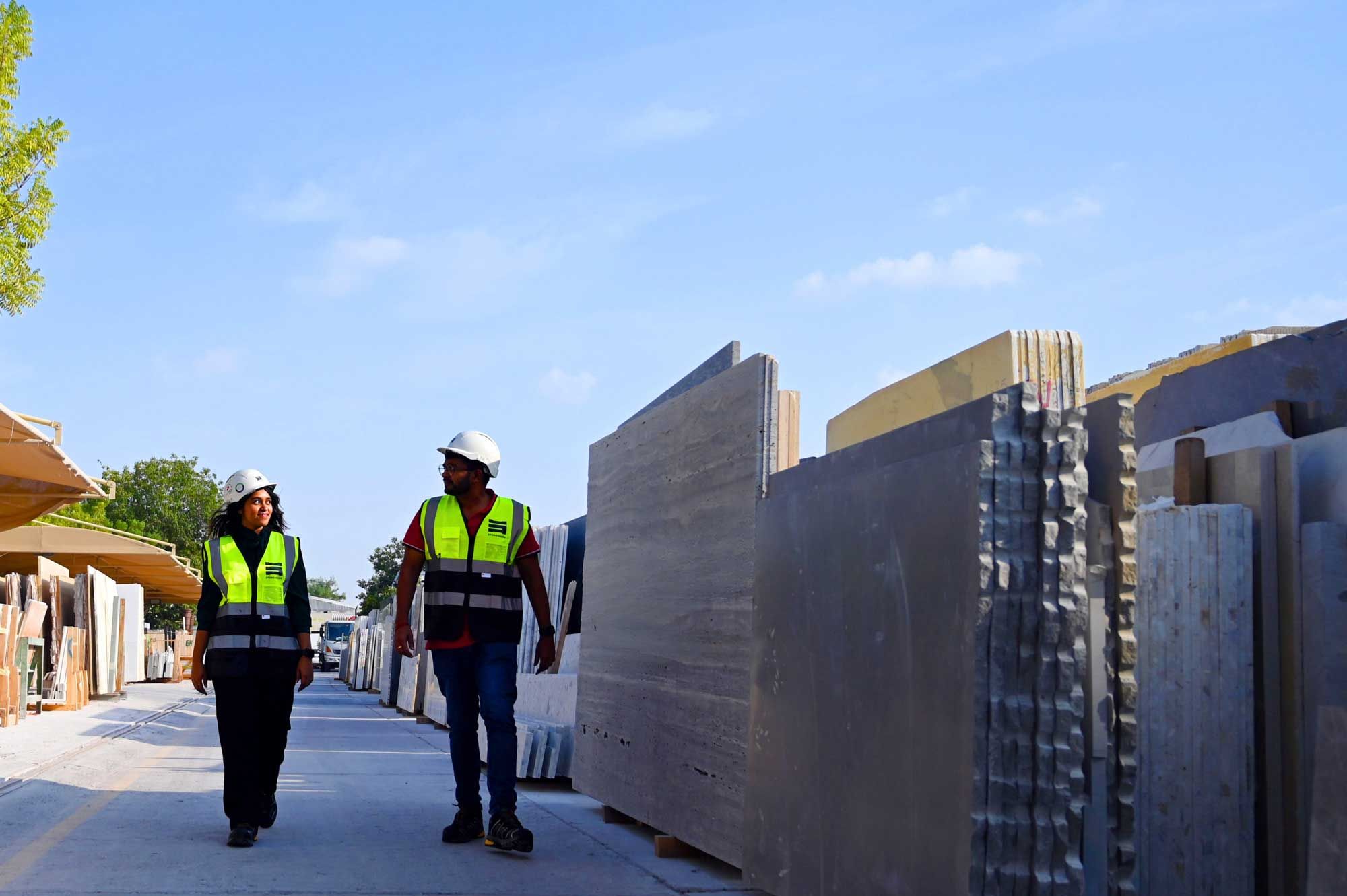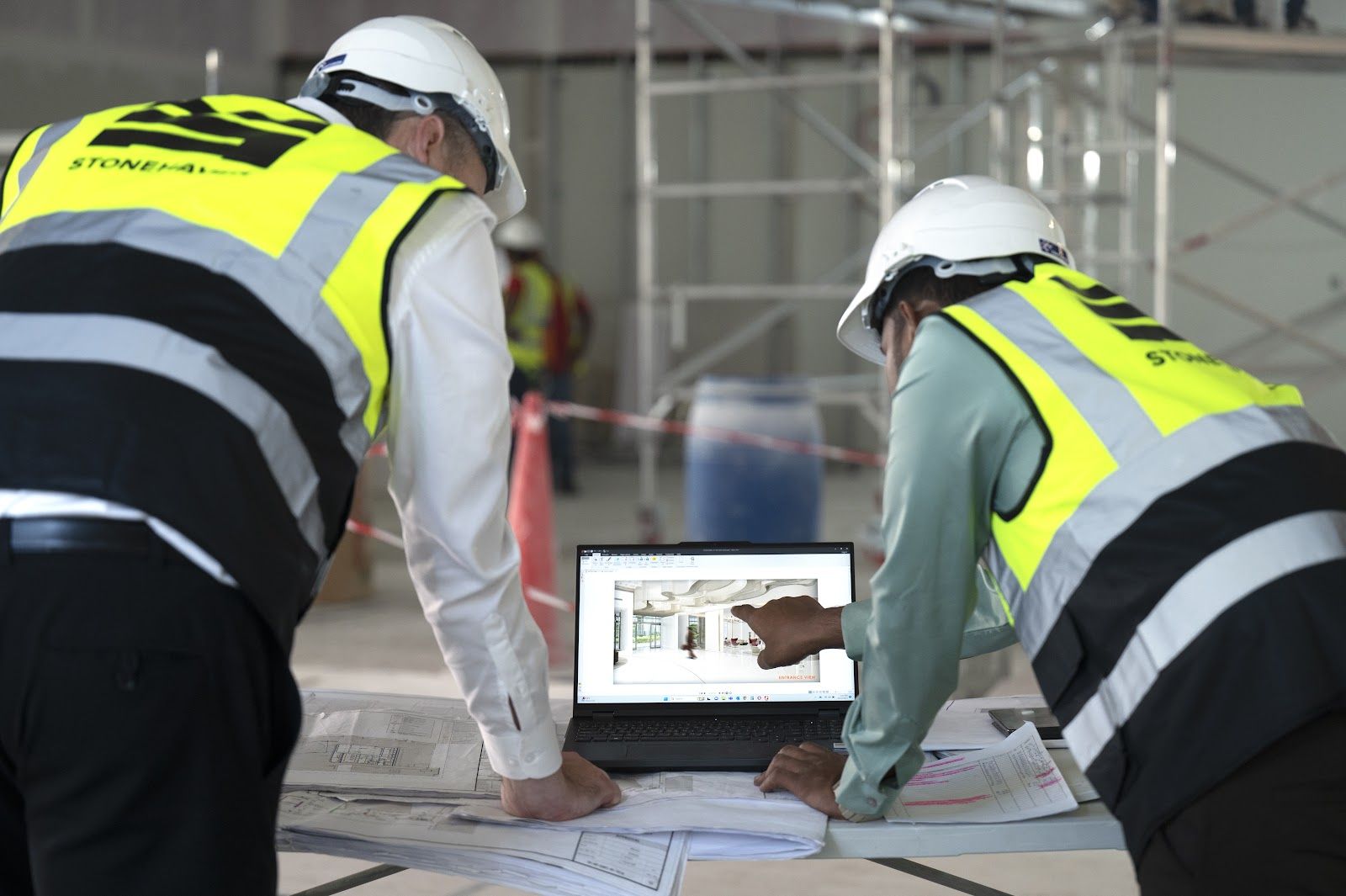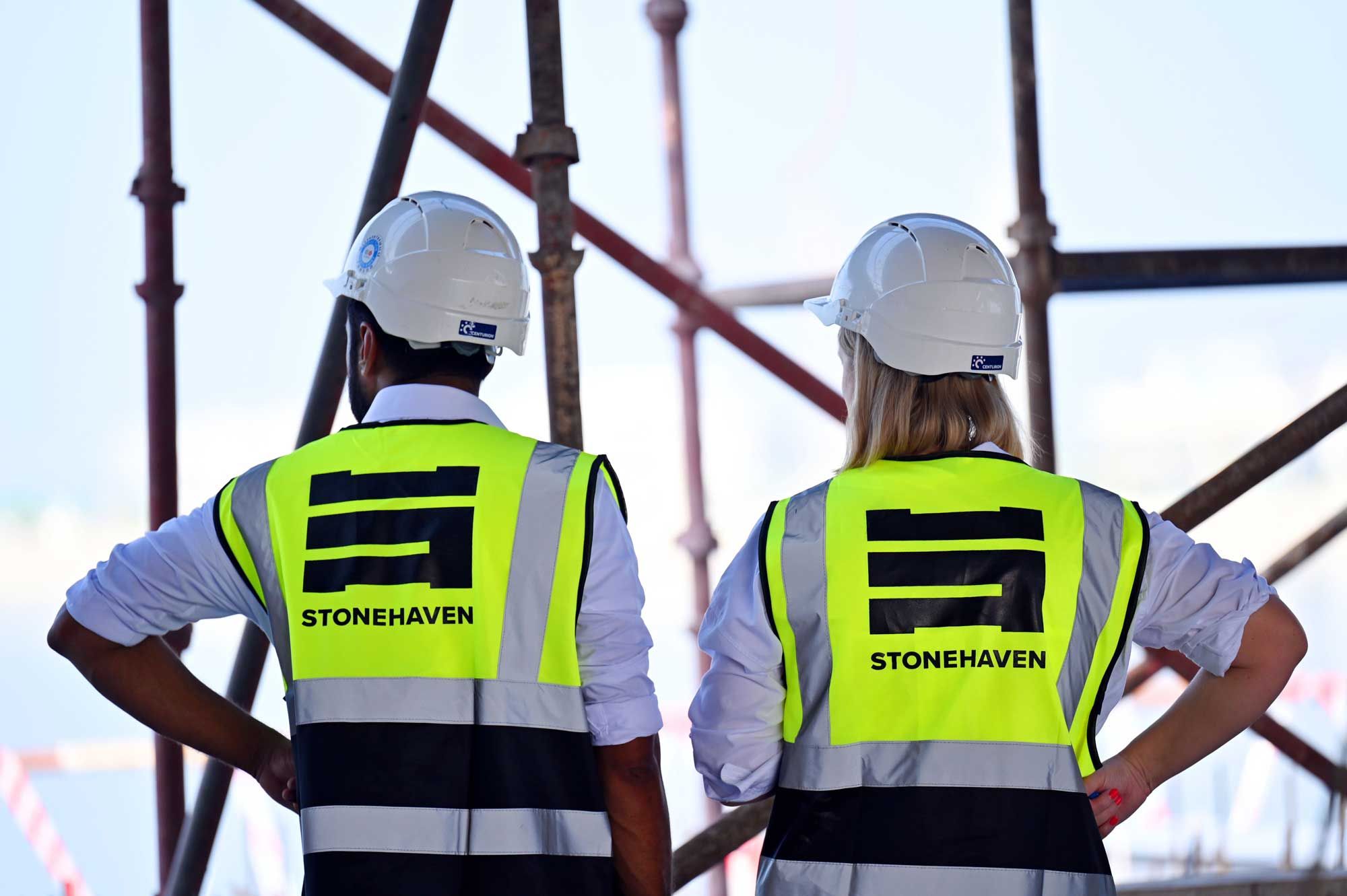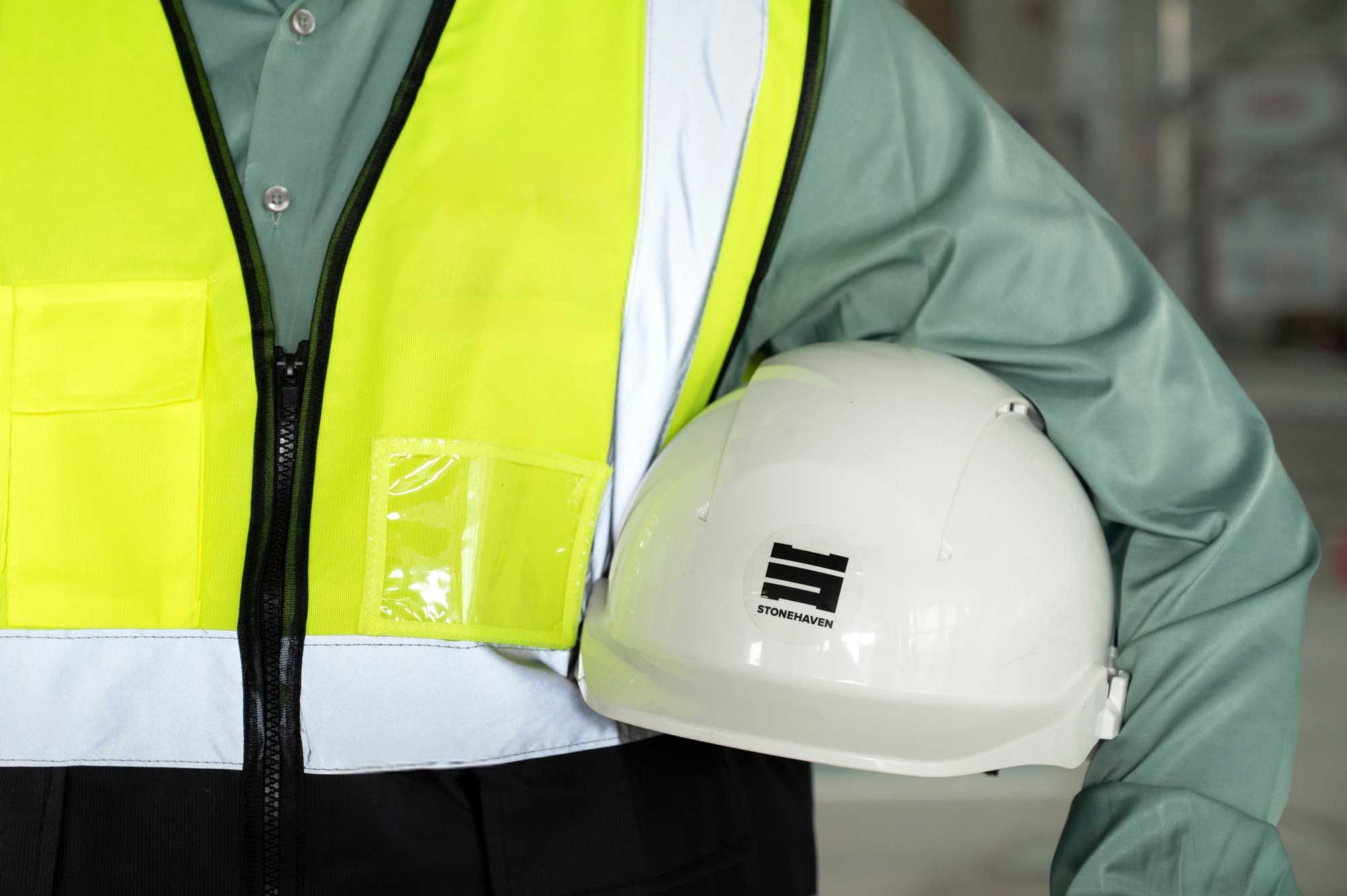Every great construction project begins long before the first brick is laid or the first crane swings into motion. Behind the scenes lies a critical component often overlooked yet fundamental to the success of any build: preliminaries in construction. These aren't the glamourous elements of towering skyscrapers or luxury interiors, but they hold the keys to how smoothly, legally, and safely a project unfolds.
Understanding preliminaries is essential not just for quantity surveyors and project managers, but also for clients, stakeholders, and anyone involved in construction cost management. Especially in regions like the UAE, where the skyline races upwards at an astonishing pace, getting a grip on preliminaries can spell the difference between profit and loss.
This guide offers a clear breakdown of preliminaries in construction, detailing what they include, how they are costed, and why they matter. Whether you’re aiming for accurate pricing, contract compliance under FIDIC or GCC standards, or improved risk control, you’ll gain the insight needed to manage preliminaries with confidence.
What Are Preliminaries in Construction?
Preliminaries in construction refer to the temporary works, services, and site establishment activities required before and during the physical building process. While they are not part of the permanent structure, they are foundational to ensuring project success. Common preliminary items include site access, temporary utilities, scaffolding, site hoarding, welfare facilities, health and safety systems, insurance, project supervision, and securing permits. These are necessary to meet legal, logistical, and operational requirements.
In the UAE and broader GCC region, construction preliminaries are governed by industry frameworks such as the FIDIC Red Book (2017) and the GCC Standard Form of Contract. These frameworks mandate the inclusion of preliminaries in the Bill of Quantities, ensuring clarity in responsibility and cost allocation from the outset.
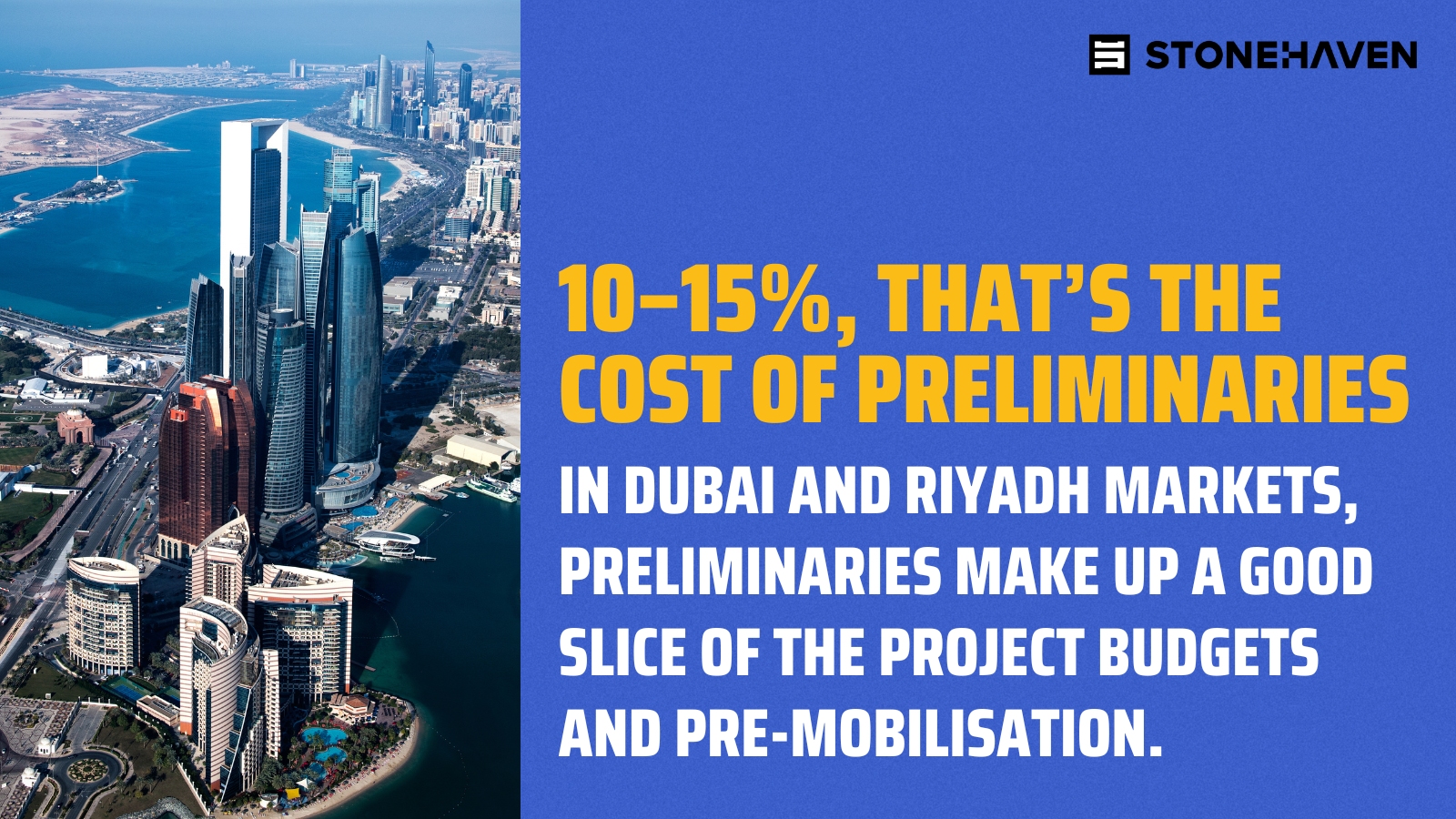
According to the Turner & Townsend 2024 Market Report, preliminaries in markets such as Dubai and Riyadh typically represent 10% to 15% of overall construction costs. Furthermore, the RICS Global Construction Monitor Q1 2024 identifies early mobilisation challenges as a key source of delay across MENA projects, underscoring the importance of detailed preliminary planning.
Far from being ancillary expenses, preliminaries are the operational backbone of any successful construction project. They provide the legal, logistical, and infrastructural foundation upon which compliant and efficient project execution is built.
What are the types of Preliminaries in Construction?
1. Site Establishment
Site establishment involves all the initial physical setup costs required to make a project site operational. This includes the construction and installation of temporary site offices, welfare facilities such as toilets and changing rooms, fencing, hoarding, and access control points. Logistics coordination, delivery zones, and temporary storage areas also fall under this category, enabling construction teams to begin works safely and efficiently.
2. Site Management and Supervision
This category includes the cost of staff who manage and supervise day-to-day site operations. Key personnel typically include the site manager, supervisors, health and safety officers, document controllers, administrative support, and security staff. These roles are crucial in ensuring that work is monitored, quality is maintained, and compliance obligations are met.
3. Temporary Works and Services
Temporary works refer to non-permanent structures and equipment needed to carry out the project. These may include scaffolding, temporary formwork, hoists, cranes, and generators. Services such as water supply, electrical distribution, and site drainage systems are essential to maintain functional operations but are not retained in the completed building.
4. Health, Safety & Environmental (HSE) Compliance
Safety compliance costs are a vital part of any project in the UAE, where regulations are strictly enforced. This includes providing personal protective equipment (PPE), installing safety signage, conducting induction training, and implementing dust suppression, noise control, and waste management strategies. Provisions for firefighting equipment and emergency facilities also fall under this category, ensuring the site remains safe and compliant throughout the build.
5. Regulatory, Legal, and Insurance Requirements
Legal and insurance obligations must be addressed early. These include the provision of Advance Payment Guarantees, Performance Bonds, and various forms of insurance such as Contractor’s All Risks (CAR), Public Liability, and Employer’s Liability. In parallel, the costs and coordination associated with securing permits and approvals from authorities such as DEWA, Civil Defence, and local municipalities must be included.
6. Project Management and Overheads
This category covers strategic oversight, planning, and indirect expenses associated with project delivery. Costs may include programme scheduling, coordination meetings, progress reporting, and digital tools such as BIM platforms or document control systems. Additionally, a portion of head office overheads is often allocated to the project to reflect the administrative support provided at corporate level.
7. Testing, Commissioning Support & Quality Assurance
Testing and commissioning support is required to meet performance specifications and contractual obligations. This may include producing mock-ups or sample panels, facilitating third-party testing and inspections, and assisting with the commissioning of temporary installations. It also involves preparing comprehensive QA/QC documentation to ensure the project meets required standards and client expectations.
8. Demobilisation and Site Clearance
At project close-out, costs are incurred for dismantling temporary facilities, removing scaffolding and site offices, performing a final site clean-up, and restoring any disturbed areas. Proper demobilisation ensures a smooth handover, compliance with contractual obligations, and the final release of retained payments.
9. Contingency and Risk Allowances
A prudent Quantity Surveyor will include allowances for unforeseen conditions such as regulatory delays, labour shortages, or changes in utility pricing. These risk provisions are often calculated based on the project’s complexity, location, and programme sensitivity, and provide a financial buffer to protect against uncertainty.
Why are Preliminaries Important in Construction Projects?
Construction in the UAE is characterised by ambitious timelines, complex stakeholder ecosystems, and world-class infrastructure demands. From high-rise towers and international airports to luxury resorts and mega-developments, projects here are delivered at a scale and speed that few regions match. This makes the effective planning and costing of preliminaries in construction not just advisable, but essential.
-
The local regulatory framework in the UAE imposes strict requirements on documentation, compliance, and forward planning. Every major development must adhere to rigorous standards related to safety, environmental management, and worker welfare. As a result, preliminaries are not simply part of a budgeting exercise, they are often a legal and contractual necessity.
-
Under GCC contracts, preliminaries typically capture the contractor’s obligations around labour law compliance, safety systems, and environmental protection. These elements must be accounted for clearly in the tender and contract documentation.
-
Similarly, construction preliminaries under FIDIC contracts focus on equitable risk allocation and responsibility sharing. This often requires a detailed breakdown of preliminaries in the Bill of Quantities (BOQ), promoting transparency between all parties and reducing the risk of dispute.
-
Additionally, the UAE’s harsh climate and advanced infrastructure standards introduce unique preliminary cost pressures. Projects may require air-conditioned site offices, shaded rest areas for workers, or dust suppression systems, all of which influence how to calculate preliminaries in construction accurately.
Because many UAE projects involve international developers, consultants, and contractors, preliminaries also encompass extensive coordination for permits, insurance, legal documentation, and authority approvals. These early-stage costs are central to compliance and smooth mobilisation.
Failure to budget for these items properly can delay approvals, halt site access, and expose contractors to financial penalties or regulatory issues. Understanding the preliminaries in construction within the UAE’s high-compliance, high-expectation environment is not optional—it is fundamental to project success.
How Do You Calculate Preliminaries in Construction?
Now that we know what’s included, let’s tackle how to calculate preliminaries in construction. Preliminaries are typically measured using frameworks such as the New Rules of Measurement (NRM2) published by the Royal Institution of Chartered Surveyors (RICS) or, in some infrastructure cases, the Civil Engineering Standard Method of Measurement (CESMM).
A Quantity Surveyor will consider factors such as project duration, site constraints, contractor methodology, regulatory timelines, and market rates to ensure preliminaries are priced both competitively and accurately.
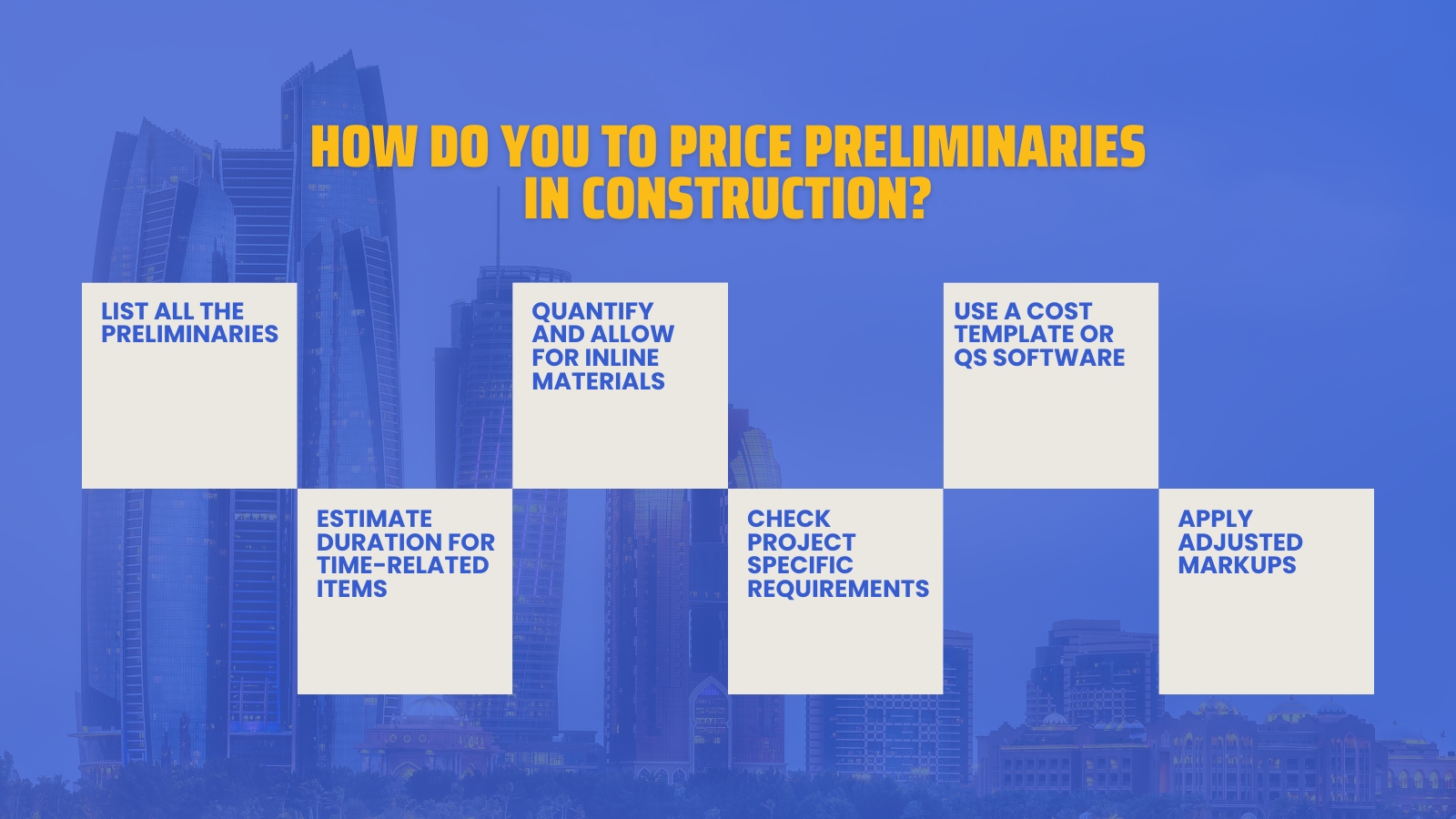
Step-by-Step Guide to Pricing Preliminaries in Construction
1. List All Preliminaries
Start by itemising all preliminary requirements based on the project scope and construction methodology. These typically include:
● Site Establishment: Hoarding, signage, access roads, temporary fencing, gates.
● Welfare Facilities: Toilets, canteens, shaded rest areas, first-aid rooms.
● Temporary Utilities: Water supply, electrical connections, generators, drainage.
● Staffing: Project manager, site engineer, HSE officer, document controller, security.
● Compliance: Insurances, authority permits, health and safety measures.
● Mobilisation and Demobilisation: Plant transport, setup and removal of temporary facilities.
● Environmental Controls: Dust suppression, noise mitigation, waste disposal.
2. Estimate Duration for Programme Items
For items such as site offices, utilities, and staff, calculate their cost by multiplying the unit rate (e.g. monthly or weekly) by the total programme duration.
Example:
● Site Office Rental: AED 15,000/month × 10 months = AED 150,000
● Project Manager: AED 45,000/month × 12 months = AED 540,000
Make sure durations reflect realistic programme expectations—especially in fast-track UAE projects.
3. Quantify and Allow for Inline Materials
Inline materials refer to consumables and short-life components used during the preliminary phase that are essential but not part of the permanent works. These may include:
● Fire Extinguishers
● PPE & Safety Signage
● Protective Sheeting and Barriers
● Temporary Lighting, Cables, and Plugs
● Consumables for Site Cleaning and Maintenance
● IT equipment and printers for site documentation
These items should be priced separately, based on frequency of replacement or project phase needs. Many are often missed in early-stage budgeting.
4. Check Regulatory and Project-Specific Requirements
Especially in the UAE and GCC:
● Dubai Municipality, Abu Dhabi DMT, and Civil Defence have specific mandates around site setup, safety systems, and environmental controls.
● Estidama and LEED projects require water-efficient toilets, shaded walkways, waste sorting facilities, and dust mitigation.
● Review the contract (FIDIC, GCC, bespoke) for any mandatory preliminaries or stated inclusions.
Don’t overlook costs such as:
● Insurance for public liability, contractor’s all-risk, and workers’ compensation
● Security fencing and CCTV, required on government projects
● Noise and vibration monitoring devices on infrastructure schemes
5. Use a Preliminaries Cost Template or QS Software
To avoid omissions and ensure structured pricing, rely on tools like:
● Excel templates pre-set with standard prelim items
● RIB or CostX or smart linkages to programme and resources
● Use of BoQ automation tools to ensure updates are tracked in line with programme changes
Ensure that every line item includes:
● Unit of measurement
● Unit rate
● Quantity or duration
● Subtotals, markups, and contingencies
6. Apply Adjusted Markups and Project Risk Factors
This is where your judgment as a QS matters most. Consider:
● Contractor overheads and profit (OHP) – often 10–15%
● Risk allowances for potential inflation in utility costs, security, or overtime
● Site location risk – remote sites may require higher mobilisation costs
● Phasing risk – split prelims per phase for multi-phase or long-duration projects
Example: Sites near water or protected zones may require additional environmental protection measures.
How Does the Preliminary Construction Process Work?
The preliminary construction process begins long before physical works commence, laying the essential groundwork—both administrative and logistical—that ensures a project can be delivered smoothly, safely, and in compliance with local regulations. The first major phase is site establishment. This includes securing all necessary permits and authority approvals, installing site fencing and hoarding, creating safe and accessible entry points, and setting up welfare facilities such as toilets, canteens, and rest areas. Temporary offices and storage containers must also be mobilised, and traffic management plans coordinated to allow safe and efficient movement of labour and materials.
Once the site is established, attention shifts to operational and running costs, which persist throughout the construction programme. A construction site functions like a temporary micro-city, requiring continuous utilities such as electricity, water, and drainage. It must also be supported by site supervision teams, temporary lighting, communication systems, security personnel, and health and safety signage. These are not incidental expenses—they are structured, ongoing costs that require careful budgeting from the outset. Neglecting them can lead to costly disruptions, compliance issues, or unsafe working environments.
Preliminaries also extend through to the final stage of the project: close-out and decommissioning. Once construction is complete, temporary facilities must be dismantled, the site cleaned and restored, and all handover documentation prepared. This includes delivering as-built drawings, completing final inspections, resolving snags, and compiling health and safety files. A well-managed close-out is not only essential for regulatory compliance and client satisfaction—it also ensures that the project is contractually wrapped up and reputationally sound.
In most construction contracts, preliminaries are itemised in a dedicated section and rightly so. They set the operational tone for the entire project, providing the critical infrastructure needed to manage teams, meet regulatory requirements, and control risk from day one. When executed well, they reduce the likelihood of delays, variations, or costly rework. However, when undervalued or omitted during tendering, they often lead to scope gaps and downstream disruptions.
Case Study on Commercial Projects
In one recent commercial office project, Stonehaven was engaged early to provide cost management services. At the outset, we developed a detailed breakdown of preliminaries including:

Examples of Preliminary Costs on Commercial Projects
● Site establishment costs (site offices, temporary hoarding, access control)
● Safety and compliance (fire safety provisions, PPE, signage, HSE management)
● Temporary utilities (water, electricity, drainage setup)
● Permitting and authority approvals (Civil Defence, municipality, public approvals)
● General management (site supervision, document control, traffic coordination)
By assessing these components early, we enabled the client to enter contractor negotiations with full visibility, reducing the chance of post-contract price adjustments and scope creep. It is important to note that these prelim costs vary from sector to sector.
How Do Experienced Construction Professional's Assess Preliminaries?
Far from being a checklist exercise, handling preliminaries effectively is about controlling risk, aligning with contract frameworks such as FIDIC and GCC, and maintaining cost efficiency from the outset. This is why appointing a QS specialist in construction cost management, someone with specific expertise in preliminaries in construction within the UAE context, should be viewed as a strategic investment rather than a mere overhead.
Partnering with a cost manager allows, project stakeholders to approach budgeting with far greater accuracy. Early-stage costs are often underestimated or omitted entirely when handled by general contractors without dedicated cost planning resources. A specialist ensures that every component, from site setup to long-term safety management, is considered, accounted, and justified. This level of precision not only reduces the likelihood of surprise costs but also increases transparency during tender reviews and financial reporting.
Conclusion
The world of construction is intricate, but one thing is clear: ignoring preliminaries is a costly mistake. These foundational elements are critical for accurate budgeting, regulatory compliance, and efficient project execution, especially in a high-stakes environment like the UAE.
Understanding preliminaries in construction means grasping both the what and the why—what is included, how to calculate, what it costs, and why it matters. As we’ve explored through real-world examples and practical guidance, managing these costs effectively isn't just about getting numbers right—it’s about safeguarding the entire lifecycle of your build.
Featured Perspective
This article includes contributions and insights from Pasindu Anuranga, Cost Manager at Stonehaven whose project experience in the industry has shaped much of this discussion.
Pasindu is a Quantity Surveyor with four years of experience in the construction industry. He has worked on a variety of projects, specialising in cost estimation, contract administration, and construction management. With a strong analytical approach and attention to detail, he is committed to delivering cost-effective solutions and maximising value in construction projects.
About us
Stonehaven is a trusted name in the field of construction cost management, proudly operating from the heart of the UAE. Our mission is to support clients across the region with strategic, data-driven solutions that bring clarity, control, and consistency to every stage of a construction project. From private developments to large-scale infrastructure and complex public sector initiatives, we have built a reputation for delivering measurable value through accuracy, insight, and meticulous execution.
We don’t just help clients comply with regulations; we help them build smarter by demystifying how to calculate preliminaries in construction, identifying cost-saving opportunities, and aligning early-stage planning with long-term objectives. Whether it’s preliminary cost analysis, BOQ preparation, contract negotiation, or continuous commercial management, our integrated services ensure that no aspect of the budget is left to chance.
We understand exactly what is included in preliminaries in construction and how to manage each component efficiently, transparently, and strategically. Let’s build smarter, together.




